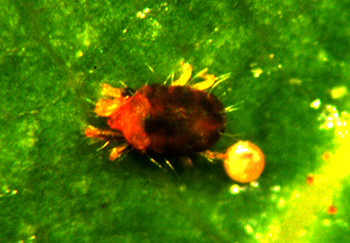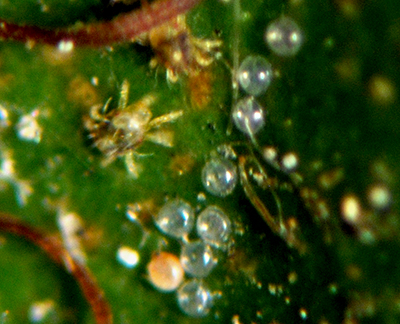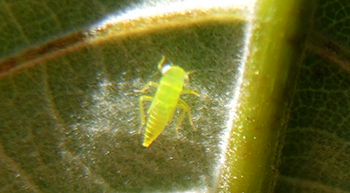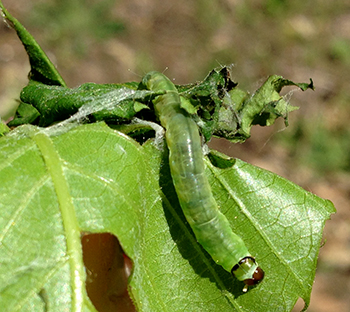Michigan chestnut update – July 31, 2014
European red mite populations are building in area orchards and potato leafhopper damage is becoming more apparent. Growers should be scouting for these pests regularly and monitoring pressure.

Growing degree day (GDD) accumulation is significantly different along the western portion of the state with the weather drying out for most areas. As of July 31, the Benton Harbor Enviro-weather station has accumulated 1,505 GDD50 with 0.19 inches of rain over the past week; the Clarksville Enviro-weather station has recorded 1,359 GDD50 and 0.13 inches of rain; the Bear Lake Enviro-weather station has accumulated 1,181 GDD50 and 0.03 inches of rain; and the Northwest Michigan Horticultural Research Center accumulated 1,199 GDD50 with just under 0.52 inches of rain this past week. Burrs are sizing nicely in the northwest.
Spider mite populations have increased over the past weeks as the weather has dried out. At this time we are observing a large number of adults, larvae and eggs in Michigan orchards. Chestnut trees are susceptible to feeding damage from a number of spider mite species including European red mite and two-spotted spider mites. Affected leaves appear mottled or bronzed and become brittle leading to early defoliation and reduced photosynthetic activity (see photos below). Reduced photosynthesis can lead to reduced nut size and return crop load in subsequent years as well as increased sensitivity to winter injury. At this time, no treatment thresholds are established for mites in chestnut, but evidence from crops like cherries indicate that some level of feeding is likely tolerable and that higher populations can be tolerated as the season progresses through summer.
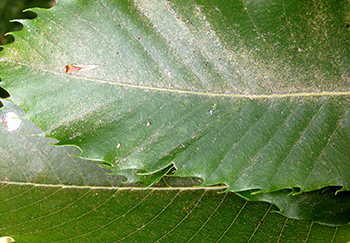
Left, Chestnut leaves bronzing from European red mite feeding. Note the mites are visible as tiny, red specks. Right, Magnified European red mite adult with egg next to leaf vein. Photo credits: Erin Lizotte, MSU Extension
European red mites overwinter as eggs in bark crevices and bud scales. Eggs are small spheres, about the size of the head of a pin with a single stipe or hair that protrudes from the top (this is not always visible). Eggs can be viewed with a hand lens or the naked eye once you have established what you are looking for. Growers can scout for overwintering eggs early in the spring to assess population levels in the coming season. As temperatures warm, overwintering eggs hatch and immature mites called larvae move onto the emerging leaves and start feeding. Adult European red mites are red and have hairs that give them a spikey appearance (see photo above of European red mite). The larvae appear as smaller versions of the adult.
Adult and larval feeding occurs on the upper leaf surface in chestnut, likely due to the velvety underside of the leaves. The first generation is the slowest of the season and typically takes a full three weeks to develop and reproduce. This slow development is due to the direct link between temperature and mite development. Summer generations, favored by the hot and dry weather, are able to complete their lifecycles much faster with as little as 10 days between generations under ideal conditions.
Growers should also be looking for two-spotted spider mites when scouting. Two-spotted spider mite larvae and adults have two distinct spots located on the front half of the body. Eggs are spherical and translucent and are often found along leaf veins. Nymphs and adults can be a variety of colors, depending on the time of the year and stage of development. Potential colors include orange, brown, pale yellow or green, so growers are encouraged to use the spots as the key identification characteristic.
Two-spotted spider mites overwinter as adults around the base of trees in the duff. As the weed or grass cover under the trees dries out, two-spotted spider mites start to move back up into the canopy in higher numbers from tight cluster through harvest. Like European red mites, two-spotted spider mites damage the tree by feeding on the foliage and give the leaves a dirty appearance when populations become high and leaf surfaces are coated in eggs, discarded exoskeletons from molting and webbing.
Two-spotted spider mite adult alongside clear, hatched egg. Photo credit: Erin Lizotte, MSU Extension
Mite control starts with monitoring early in the spring, looking for the overwintering European red mite eggs and two-spotted spider mite adults and includes tracking the mite pressure over time. Ideally, growers should limited broad spectrum insecticides (e.g., pyrethroids) in their insect management programs as that helps protects beneficial mite populations which provide for natural control. If pest mite populations are high enough to require control, dormant superior oil applications are an effective method of treatment and should be applied in the spring. Ensuring adequate coverage is critical to attaining optimal control on problem sites as oil alone acts to smother mites and eggs. If you are applying an oil with an additional insecticidal property, such as those containing the neem extract azadirachtin, coverage is still critical as many are insect growth regulators and have antifeedant properties. Oil application comes with a risk of phytotoxicity, particularly as green tissue emerges.
It is recommended that growers do a small test spray if they have not used dormant oils in the past. Keep in mind that different cultivars may have different sensitivities and proceed with caution. Severely stressed trees should never be sprayed with oil and growers are advised to keep in mind that temperature and humidity also play a role in the risk of phytotoxicity. Temperatures above 80 degrees Fahrenheit and slow drying time (high humidity) increase the chance of damage. Oil also has some potential compatibility issues growers should be aware of including Captan and sulfur.
Lastly, it is not recommended that oil be applied within a 48-hour window prior to and following freezing temperatures due to decreased efficacy and potential plant damage. Read and follow all label directions carefully to minimize the risk of spray damage.
If populations build to damaging levels in the summer months, growers should focus on applying true miticides when treatment is necessary. Active ingredients with activity against mites include abamectin, fenpyroximate, pyridaben, spirodiclofen, etoxazole, hexythiazox, acequinocyl, and bifenezate. Refer to the Michigan State University Extension publication, “Pesticides Registered for Edible Chestnuts, 2014” for labeled products containing these active ingredients. Again, growers should avoid the application of pyrethroids to reduce future mite flaring.
As growers are scouting, they are encouraged to remember that not all mites are bad. Consider documenting the levels of predacious mites in your orchard. If healthy populations of mite predators exist, they will continue to feed on plant parasitic eggs and nymphs and can be an effective component of your mite management program. The three most important predaceous mites are Amblyseius fallacis (Phytoseiidae), Agistemus fleschneri (Stigmaeidae), and Zetzellia mali (Stigmaeidae). See “A Pocket Guide for IPM Scouting in Michigan Apples” for pictures. Predaceous mites are smaller than adult European red mites and two-spotted spider mites, but they can be seen with a hand lens and typically move very quickly across leaf surfaces.
Potato leafhopper populations continue to thrive with a significant number of adults, nymphs and eggs on many host crops around the state. Like many plants, chestnuts are sensitive to the saliva that potato leafhoppers inject while feeding. Damage to leaf tissue can cause reduced photosynthesis, which can impact production, decrease nut quality and damage the tree.
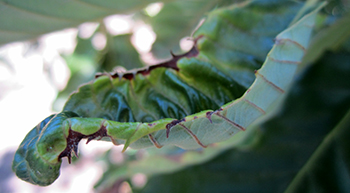
Left, A cupped leaf with necrotic edges caused by potato leafhopper feeding. Right, a wingless potato leafhopper nymph on the underside of a leaf. Photo credits: Erin Lizotte, MSU Extension
Early detection is important to prevent injury. Spring scouting should be performed following storm systems originating in the southern United States and weekly after first detection to monitor populations and treatment efficacy. For every acre of orchard, growers should select five trees to examine and inspect the leaves on three shoots per tree, a total of 15 shoots per acre. The easiest way to observe potato leafhoppers is by flipping the shoots or leaves over and looking for adults and nymphs on the underside of leaves. Pay special attention to succulent new leaves on the terminals of branches. Growers may also shake branches and watch for the winged adults to take flight as a quick test.
Symptoms of feeding appear as whitish dots arranged in triangular shapes near the edges. Heavily damaged leaves are cupped with dead or yellowing chlorotic margins and eventually fall from the tree. Severely infested shoots produce small, bunched leaves with reduced photosynthetic capacity.
The most common classes of insecticides recommended for control of potato leafhoppers include the pyrethroids (bifenthrin, beta-cyfluthrin, cyfluthrin, gamma-cyhalothrin, lambdacyhalothrin, pyrethrins, zeta-cypermethrin, deltamethrin and fenpropathrin), carbamates (carbaryl), neonicotinoids (imidacloprid, thiamethoxam, acetamiprid and clothianidin) and organophosphates (malathion and phosmet). Refer to “Pesticides Registered for Edible Chestnuts, 2014” for labeled products containing these active ingredients. Carbamates and organophosphates are broad spectrum and can disrupt natural enemies, so only use when necessary to rotate insecticidal mode of action or to target another pest at the same time. Pyrethroids are also effective at controlling potato leafhoppers and remain relatively inexpensive. However, pyrethroids have been shown to cause increases in mite populations in other crops and should be used judiciously, particularly early in the season when mite populations have time to build over the season. Neonicotinoids are longer lasting and narrow spectrum making them a solid choice for management.
Japanese beetle activity is subsiding for most growers; some reported relatively high populations this season. Obliquebanded leafroller activity is picking up again with larvae of various sizes rolling leaves in area orchards. Obliquebanded leafrollers feed on leaves and are not considered to be of economic significance for chestnut producers.
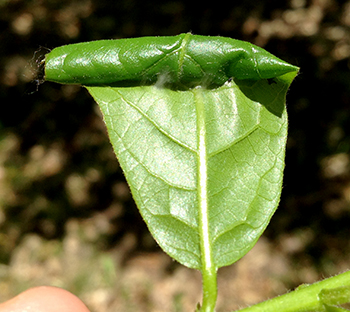
Left, Chestnut leaf tip rolled under by an obliquebanded leafroller. Right, Obliquebanded leafroller larva. Photo credits Erin Lizotte, MSU Extension



 Print
Print Email
Email